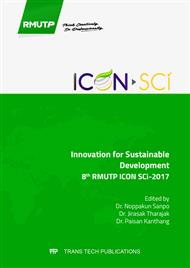[1]
C. Paludan-Müller, M. Madsen, P. Sophanodora, L. Gram, P. L. Møller, Fermentation and microflora of Plaa-som, a Thai fermented fish product prepared with different salt concentrations. Inter. J. Food Microbiol. 73 (2002) 61–70.
DOI: 10.1016/s0168-1605(01)00688-2
Google Scholar
[2]
M. Olympia, H. Ono, A. Shinmyo, M. Takano, Lactic acid bacteria in fermented fishery product, Burong bagus,. J. Ferment. Bioeng. 73 (1992) 193-197.
DOI: 10.1016/0922-338x(92)90159-r
Google Scholar
[3]
N. Bernbom, Y. Y. Ng, C. Paludan-Muller, L. Gram, Survival and growth of Salmonella and Vibrio in som-fak, a Thai low-sat garlic containing fermented fish product. Inter. J. Food Microbiol. 130 (2009) 223-229.
DOI: 10.1016/j.ijfoodmicro.2009.06.012
Google Scholar
[4]
C. Paludan-Müller, H. H. Huss, L. Gram, Characterization of lactic acid bacteria isolated from a Thai low-salt fermented fish product and the role of garlic as substrate for fermentation. Inter. J. Food Microbiol. 46 (1999) 219–229.
DOI: 10.1016/s0168-1605(98)00204-9
Google Scholar
[5]
J. D. Owens, L. S. Mendoza, Enzymatically hydrolysed and bacterially fermented fishery products. J. Food Technol. 20 (1985) 273–293.
Google Scholar
[6]
C. H. Lee, Lactic acid fermented foods and their benefits in Asia. Food Control 8 (1997) 259–269.
Google Scholar
[7]
Y. Motarjemi, Impact of small scale fermentation technology on food safety in developing countries. Int. J. Food Microbiol. 75 (2002) 213–229.
DOI: 10.1016/s0168-1605(01)00709-7
Google Scholar
[8]
A. Østergaard, P. K. Ben Embarek, C. WEdel-Neergaard, H. H. Huss, L. Gram, Characterization of anti-listerial lactic acid bacteria isolated from Thai fermented fish products. Food Microbiol. 15 (1988) 223-233.
DOI: 10.1006/fmic.1997.0153
Google Scholar
[9]
H. Hwanhlem, S. Buradaleng, S. Wattanachant, S. Benjakul , A. Tani , S. Maneerat, Isolation and screening of lactic acid bacteria from Thai traditional fermented fish (Plasom) and production of Plasom from selected strains. Food Control 22 (2011).
DOI: 10.1016/j.foodcont.2010.09.010
Google Scholar
[10]
C. P. Muller, H. H. Huss, L. Gram, Characterization of lactic acid bacteria isolated from a Thai low-salt fermented fish product and the role of garlic as substrate for fermentation. Inter. J. Food Microbiol. 46 (1999) 219-229.
DOI: 10.1016/s0168-1605(98)00204-9
Google Scholar
[11]
P. Saithong, W. Panthavee, M. Boonyaratanakornkit, C. Sikkhamondhol, Use of a starter culture of lactic acid bacteria in plaa-som, a Thai fermented fish. J. Biosci. Bioeng. 110 (2010) 553-557.
DOI: 10.1016/j.jbiosc.2010.06.004
Google Scholar


